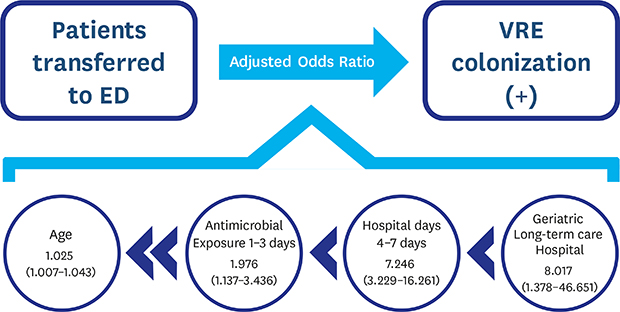1. van Schaik W, Willems RJ. Genome-based insights into the evolution of enterococci. Clin Microbiol Infect. 2010; 16(6):527–532.

2. Lebreton F, Willems RJ, Gilmore MS. Enterococcus diversity, origins in nature, and gut colonization. Enterococci: from commensals to leading causes of drug resistant infection. Boston, MA: Massachusetts Eye and Ear Infirmary;2014. Updated 2014. Accessed October 17, 2018.
https://www.ncbi.nlm.nih.gov/books/NBK190427/.
3. Fisher K, Phillips C. The ecology, epidemiology and virulence of Enterococcus
. Microbiology. 2009; 155(Pt 6):1749–1757.
4. Lebreton F, van Schaik W, McGuire AM, Godfrey P, Griggs A, Mazumdar V, et al. Emergence of epidemic multidrug-resistant
Enterococcus faecium from animal and commensal strains. MBio. 2013; 4(4):e00534-13.

5. Zirakzadeh A, Patel R. Vancomycin-resistant enterococci: colonization, infection, detection, and treatment. Mayo Clin Proc. 2006; 81(4):529–536.

6. Ahmed MO, Baptiste KE. Vancomycin-resistant enterococci: a review of antimicrobial resistance mechanisms and perspectives of human and animal health. Microb Drug Resist. 2018; 24(5):590–606.

7. Leclercq R, Derlot E, Duval J, Courvalin P. Plasmid-mediated resistance to vancomycin and teicoplanin in Enterococcus faecium
. N Engl J Med. 1988; 319(3):157–161.
8. Favero MS, Gaynes RP, Jarvis WR, Shaw J, Tablan OC, Tenover FC. Recommendations for preventing the spread of vancomycin resistance; recommendations of the Hospital Infection Control Practices Advisory Committee (HICPAC). MMWR Recomm Rep. 1995; 44(RR-12):1–13.
9. Tacconelli E, Karchmer AW, Yokoe D, D'Agata EM. Preventing the influx of vancomycin-resistant enterococci into health care institutions, by use of a simple validated prediction rule. Clin Infect Dis. 2004; 39(7):964–970.

10. Yoon YK, Kim HJ, Lee WJ, Lee SE, Yang KS, Park DW, et al. Clinical prediction rule for identifying patients with vancomycin-resistant enterococci (VRE) at the time of admission to the intensive care unit in a low VRE prevalence setting. J Antimicrob Chemother. 2012; 67(12):2963–2969.

11. Gozaydin A, Kose S, Ece G, Ersan G, Gonullu M. Detection of vancomycin resistant enterococci from rectal swab samples by Becton-Dickinson GeneOhm VanR assay and culture at ICU of a Tertiary Care Center in Turkey. Pak J Med Sci. 2013; 29(2):682–686.

12. Kim JH, Kim JW, Kim SY, Hong DY, Park SO, Baek KJ, et al. Validation of the Korean triage and acuity scale compare to triage by emergency severity index for emergency adult patient: preliminary study in a tertiary hospital emergency medical center. J Korean Soc Emerg Med. 2016; 27:436–441.
13. Kim YJ, Kim SI, Kim YR, Lee JY, Park YJ, Kang MW. Risk factors for vancomycin-resistant enterococci infection and mortality in colonized patients on intensive care unit admission. Am J Infect Control. 2012; 40(10):1018–1019.

14. Kim YJ, Kim SI, Choi JY, Yoon SK, You YK, Kim DG. Clinical significance of methicillin-resistant Staphylococcus aureus and vancomycin-resistant enterococci colonization in liver transplant recipients. Korean J Intern Med. 2015; 30(5):694–704.
15. Yeung CS, Cheung CY, Chan YH, Chak WL. risk factors and outcomes of vancomycin-resistant Enterococcus colonization in patients on peritoneal dialysis: a single-center study in Hong Kong. Perit Dial Int. 2017; 37(5):556–561.
16. Gruber I, Heudorf U, Werner G, Pfeifer Y, Imirzalioglu C, Ackermann H, et al. Multidrug-resistant bacteria in geriatric clinics, nursing homes, and ambulant care--prevalence and risk factors. Int J Med Microbiol. 2013; 303(8):405–409.
17. Mody L, Foxman B, Bradley S, McNamara S, Lansing B, Gibson K, et al. Longitudinal assessment of multidrug-resistant organisms in newly admitted nursing facility patients: implications for an evolving population. Clin Infect Dis. 2018; 67(6):837–844.

18. Gouliouris T, Warne B, Cartwright EJ, Bedford L, Weerasuriya CK, Raven KE, et al. Duration of exposure to multiple antibiotics is associated with increased risk of VRE bacteraemia: a nested case-control study. J Antimicrob Chemother. 2018; 73(6):1692–1699.

19. Nucleo E, Caltagirone M, Marchetti VM, D'Angelo R, Fogato E, Confalonieri M, et al. Colonization of long-term care facility residents in three Italian Provinces by multidrug-resistant bacteria. Antimicrob Resist Infect Control. 2018; 7(1):33.








 PDF
PDF Citation
Citation Print
Print




 XML Download
XML Download